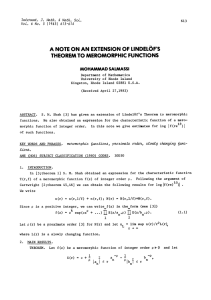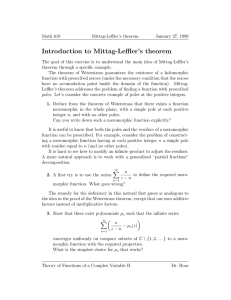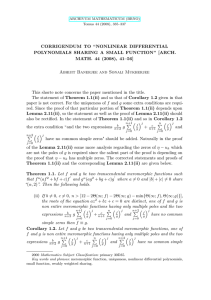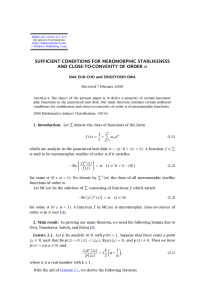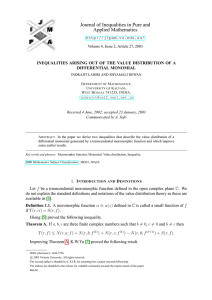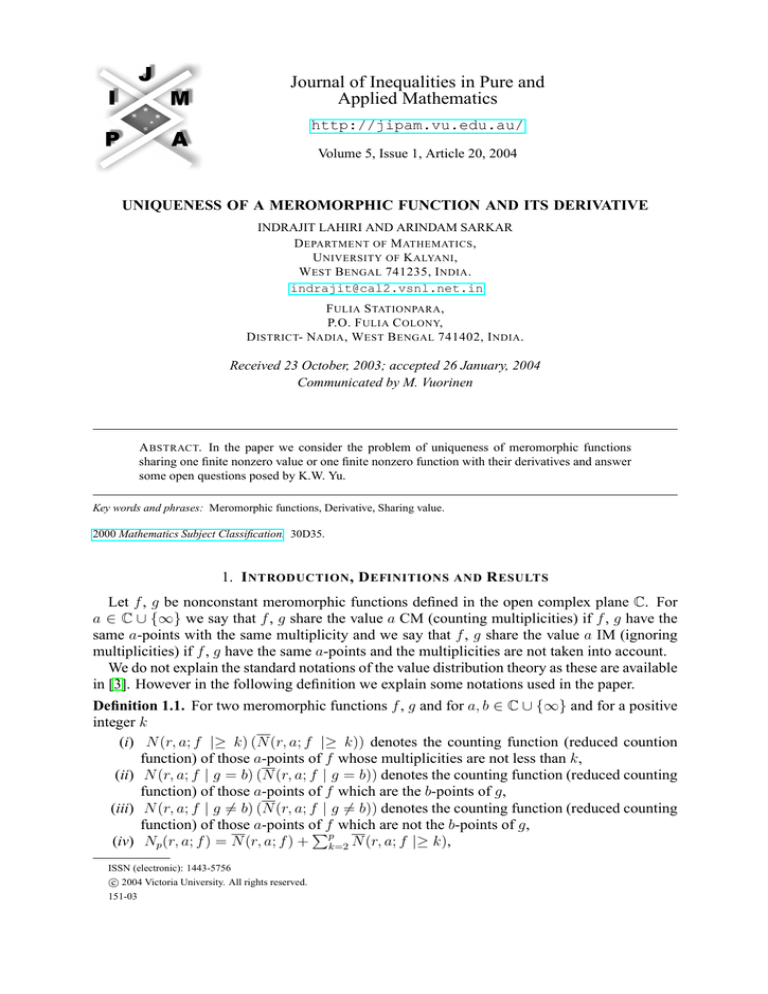
Journal of Inequalities in Pure and
Applied Mathematics
http://jipam.vu.edu.au/
Volume 5, Issue 1, Article 20, 2004
UNIQUENESS OF A MEROMORPHIC FUNCTION AND ITS DERIVATIVE
INDRAJIT LAHIRI AND ARINDAM SARKAR
D EPARTMENT OF M ATHEMATICS ,
U NIVERSITY OF K ALYANI ,
W EST B ENGAL 741235, I NDIA .
indrajit@cal2.vsnl.net.in
F ULIA S TATIONPARA ,
P.O. F ULIA C OLONY,
D ISTRICT- NADIA , W EST B ENGAL 741402, I NDIA .
Received 23 October, 2003; accepted 26 January, 2004
Communicated by M. Vuorinen
A BSTRACT. In the paper we consider the problem of uniqueness of meromorphic functions
sharing one finite nonzero value or one finite nonzero function with their derivatives and answer
some open questions posed by K.W. Yu.
Key words and phrases: Meromorphic functions, Derivative, Sharing value.
2000 Mathematics Subject Classification. 30D35.
1. I NTRODUCTION , D EFINITIONS AND R ESULTS
Let f , g be nonconstant meromorphic functions defined in the open complex plane C. For
a ∈ C ∪ {∞} we say that f , g share the value a CM (counting multiplicities) if f , g have the
same a-points with the same multiplicity and we say that f , g share the value a IM (ignoring
multiplicities) if f , g have the same a-points and the multiplicities are not taken into account.
We do not explain the standard notations of the value distribution theory as these are available
in [3]. However in the following definition we explain some notations used in the paper.
Definition 1.1. For two meromorphic functions f , g and for a, b ∈ C ∪ {∞} and for a positive
integer k
(i) N (r, a; f |≥ k) (N (r, a; f |≥ k)) denotes the counting function (reduced countion
function) of those a-points of f whose multiplicities are not less than k,
(ii) N (r, a; f | g = b) (N (r, a; f | g = b)) denotes the counting function (reduced counting
function) of those a-points of f which are the b-points of g,
(iii) N (r, a; f | g 6= b) (N (r, a; f | g 6= b)) denotes the counting function (reduced counting
function) of those a-points of
Pfp which are not the b-points of g,
(iv) Np (r, a; f ) = N (r, a; f ) + k=2 N (r, a; f |≥ k),
ISSN (electronic): 1443-5756
c 2004 Victoria University. All rights reserved.
151-03
2
I NDRAJIT L AHIRI
AND
A RINDAM S ARKAR
(v) N2 (r, a; f | g = b) (N2 (r, a; f | g 6= b)) denotes the counting function of those a-points
of f which are (are not) the b-points of g, where an a-point of f with multiplicity m is
counted m times if m ≤ 2 and twice if m > 2,
(vi) N (r, a; f |≤ k) (N (r, a; f |≤ k)) denotes the counting function (reduced countion
function) of those a-points of f whose multiplicities are not greater than k.
Definition 1.2. Let f and g share a value a IM. Let z be an a-point of f and g with multiplicities
pf (z) and pg (z) respectively. We put
ν f (z) = 1 if pf (z) 6= pg (z)
= 0 if pf (z) = pg (z).
P
Let n∗ (r, a; f, g) = |z|≤r ν f (z) and N ∗ (r, a; f, g) be the integrated counting function obtained from n∗ (r, a; f, g) in the usual manner.
Clearly N ∗ (r, a; f, g) ≡ N ∗ (r, a; g, f ).
Rubel-Yang [8], Mues-Steinmetz [7], Gundersen [2], Yang [9] considered the uniqueness
problem of entire functions with their first and k th derivatives involving two CM or IM values.
R. Brück [1] considered the uniqueness problem of an entire function when it shares a single
value CM with its derivative and proved the following theorem.
Theorem A. [1] Let f be a nonconstant entire function. If f and f 0 share the value 1 CM and
0 −1
N (r, 0; f 0 ) = S(r, f ) then ff −1
is a nonzero constant.
For entire functions of finite order Yang [10] improved Theorem A and proved the following
result.
Theorem B. [10] Let f be a nonconstant entire function of finite order and let a(6= 0) be a
(k)
finite constant. If f , f (k) share the value a CM then f f −a−a is a nonzero constant, where k(≥ 1)
is an integer.
Zhang [12] extended Theorem A to meromorphic functions and proved the following results.
Theorem C. [12] Let f be a nonconstant meromorphic function. If f and f 0 share 1 CM and if
(1.1)
N (r, ∞; f ) + N (r, 0; f 0 ) < {λ + o(1)}T (r, f 0 )
for some constant λ ∈ (0; 1/2), then
f 0 −1
f −1
is a nonzero constant.
Theorem D. [12] Let f be a nonconstant meromorphic function. If f and f (k) share 1 CM and
if
(1.2)
2N (r, ∞; f ) + N (r, 0; f 0 ) + N (r, 0; f (k) ) < {λ + o(1)}T (r, f (k) )
for some constant λ ∈ (0; 1), then
f (k) −1
f −1
is a nonzero constant.
Considering f (z) = 1 + tan z we can verify that in Theorems C and D it is not possible to
relax simultaneously the conditions (1.1) and (1.2) respectively and the nature of sharing the
value from CM to IM. Naturally one will desire to see how far it is possible to relax the nature
of sharing the value 1. In the paper we deal with this problem with the aid of the notion of
weighted sharing of values as introduced in [4, 5] and we see that it is indeed possible to some
extent, at the cost of some change in the condition (1.2).
Zheng-Wang [13] considered the uniqueness problem of entire functions sharing two small
functions CM with their derivatives. Recently Yu [11] considered the uniqueness problem of an
entire or meromorphic function when it shares one small function with its derivative. He proved
the following two theorems.
J. Inequal. Pure and Appl. Math., 5(1) Art. 20, 2004
http://jipam.vu.edu.au/
U NIQUENESS OF A M EROMORPHIC F UNCTION
3
Theorem E. [11] Let f be a nonconstant entire function and a ≡ a(z) be a meromorphic
function such that a 6≡ 0, ∞ and T (r, a) = o{T (r, f )} as r → ∞. If f − a and f (k) − a share
the value 0 CM and δ(0; f ) > 3/4 then f ≡ f (k) , where k is a positive integer.
Theorem F. [11] Let f be a nonconstant nonentire meromorphic function and a ≡ a(z) be a
meromorphic function such that a 6≡ 0, ∞ and T (r, a) = o{T (r, f )} as r → ∞. If
(i) f and a have no common pole,
(ii) f − a and f (k) − a share the value 0 CM,
(iii) 4δ(0, f ) + 2(8 + k)Θ(∞; f ) > 19 + 2k,
then f ≡ f (k) , where k is a positive integer.
Yu [11] further showed that the condition (i) of Theorem F can be dropped if k is an odd
integer. In the same paper Yu [11] posed the following open questions:
(1) Can CM shared value be replaced by an IM shared value ?
(2) Can the condition δ(0; f ) > 3/4 of Theorem E be further relaxed ?
(3) Can the condition(iii) of Theorem F be further relaxed ?
(4) Can, in general, the condition (i) of Theorem F be dropped ?
Although the fourth question is still open, in the paper we give some affirmative answers to
the first three questions imposing some restrictions on the zeros and poles of a. In the following
definition we explain the idea of weighted sharing of values which measures how close a shared
value is to be shared IM or to be shared CM.
Definition 1.3. [4, 5] Let k be a nonnegative integer or infinity . For a ∈ C ∪ {∞} we denote
by Ek (a; f ) the set of all a-points of f where an a-point of multiplicity m is counted m times
if m ≤ k and k + 1 times if m > k. If Ek (a; f ) = Ek (a; g), we say that f, g share the value a
with weight k.
The definition implies that if f , g share a value a with weight k then zo is an a-point of f
with multiplicity m(≤ k) if and only if it is an a-point of g with multiplicity m(≤ k) and zo
is an a-point of f with multiplicity m(> k) if and only if it is an a-point of g with multiplicity
n(> k) where m is not necessarily equal to n.
We write f , g share (a, k) to mean that f , g share the value a with weight k. Clearly if f , g
share (a, k) then f , g share (a, p) for all integers p, 0 ≤ p < k. Also we note that f , g share a
value a IM or CM if and only if f , g share (a, 0) or (a,∞) respectively.
Definition 1.4. We denote by δp (a; f ) the quantity
δp (a; f ) = 1 − lim sup
r→∞
Np (r, a; f )
,
T (r, f )
where p is a positive integer.
Clearly δp (a; f ) ≥ δ(a; f ).
We now state the main results of the paper.
Theorem 1.1. Let f be a nonconstant meromorphic function and k be a positive integer. If f ,
f (k) share (1, 2) and
(1.3)
2N (r, ∞; f ) + N2 (r, 0; f (k) ) + N2 (r, 0; f 0 ) < {λ + o(1)}T (r, f (k) )
for r ∈ I, where 0 < λ < 1 and I is a set of infinite linear measure, then
constant.
f (k) −1
f −1
is a nonzero
The following corollary follows from Theorem 1.1 for k = 1 and improves Theorem C.
J. Inequal. Pure and Appl. Math., 5(1) Art. 20, 2004
http://jipam.vu.edu.au/
4
I NDRAJIT L AHIRI
AND
A RINDAM S ARKAR
Corollary 1.2. Theorem C holds if the condition (1.1) is replaced by the following
N (r, ∞; f ) + N2 (r, 0; f 0 ) < {λ + o(1)}T (r, f 0 )
for some constant λ ∈ (0, 1/2).
Theorem 1.3. Let f be a nonconstant meromorphic function and k be a positive integer. If f ,
f (k) share (1, 1) and
(1.4)
2N (r, ∞; f ) + N2 (r, 0; f (k) ) + 2N (r, 0; f 0 ) < {λ + o(1)}T (r, f (k) )
for r ∈ I, where 0 < λ < 1 and I is a set of infinite linear measure, then
constant.
f (k) −1
f −1
is a nonzero
If f , f (k) share (1, 0), it is clear that f does not possess any 1-point with multiplicity greater
than k. So if in Theorem 1.1 and in Theorem 1.3 we respectively put k ≤ 2 and k = 1, it
follows that f , f (k) practically share (1, ∞). It then follows from the proof that in these cases
we can replace each of the conditions (1.3) and (1.4) by the following
2N (r, ∞; f ) + N2 (r, 0; f (k) ) + N (r, 0; f 0 ) < {λ + o(1)}T (r, f (k) )
for r ∈ I, where 0 < λ < 1 and I is a set of infinite linear measure.
It is clear that if f and f (k) satisfy the conclusions of Theorems 1.1, 1.3 then f = Aeµz + 1 −
1/c, where A, c are nonzero constants and µ is a k th root of c. So it follows that the conditions
of the theorems are necessary.
Theorem 1.4. Let f be a nonconstant meromorphic function and k be a positive integer. Let
a ≡ a(z) (6≡ 0, ∞) be a meromorphic function such that T (r, a) = S(r, f ). If
(i) a has no zero (pole) which is also a zero (pole) of f or f (k) with the same multiplicity,
(ii) f − a and f (k) − a share (0, 2),
(iii) 2δ2+k (0; f ) + (4 + k)Θ(∞; f ) > 5 + k, then f ≡ f (k) .
2. L EMMAS
In this section we present some lemmas which will be needed in the sequel.
Lemma 2.1. [3, p. 55]. Let f be a nonconstant meromorphic function. Then
T (r, f (k) ) ≤ (1 + k)T (r, f ) + S(r, f ).
Lemma 2.2. If f is a nonconstant meromorphic function and f , f (k) share (1, 0) then
1
T (r, f ) ≤ k + 2 +
T (r, f (k) ) + S(r, f ),
1+k
where k is a positive integer.
Proof. By Milloux’s basic result [3, p. 57] we get
T (r, f ) ≤ N (r, ∞; f ) + N (r, 0; f ) + N (r, 1; f (k) ) − N0 (r, 0; f (1+k) ) + S(r, f ),
where N0 (r, 0; f (1+k) ) is the counting function of those zeros of f (1+k) which are not the zeros
of f (k) − 1.
Since
N (r, 0; f ) − N0 (r, 0; f (1+k) ) ≤ (1 + k)N (r, 0; f )
and
(1 + k)N (r, ∞; f ) ≤ N (r, ∞; f (k) ) ≤ T (r, f (k) ),
J. Inequal. Pure and Appl. Math., 5(1) Art. 20, 2004
http://jipam.vu.edu.au/
U NIQUENESS OF A M EROMORPHIC F UNCTION
5
it follows that
T (r, f ) ≤
1
T (r, f (k) ) + (1 + k)N (r, 0; f ) + N (r, 1; f (k) ) + S(r, f ).
1+k
Applying this inequality to f − 1 and noting that f , f (k) share (1, 0) we obtain
1
T (r, f (k) ) + (1 + k)N (r, 1; f ) + N (r, 1; f (k) ) + S(r, f )
1+k
1
≤ 2+k+
T (r, f (k) ) + S(r, f ).
1+k
T (r, f ) ≤
This proves the lemma.
Lemma 2.3. Let f be a nonconstant meromorphic function and k be a positive integer. Then
N2 (r, 0; f (k) ) ≤ kN (r, ∞; f ) + N2+k (r, 0; f ) + S(r, f ).
Proof. By the first fundamental theorem and the Milloux theorem [3, p. 55] we get
f (1)
(1)
N r, 0; f | f 6= 0 = N r, 0;
f
f (1)
≤ N r, ∞;
+ S(r, f )
f
= N (r, ∞; f ) + N (r, 0; f ) + S(r, f ).
Also for a positive integer p
Np (r, 0; f (1) | f = 0) = N (r, 0; f |≤ p) − N (r, 0; f |≤ p) + pN (r, 0; f |≥ 1 + p).
So we get
Np (r, 0; f (1) ) ≤ N (r, 0; f (1) | f 6= 0) + Np (r, 0; f (1) | f = 0)
≤ N (r, ∞; f ) + Np+1 (r, 0; f ) + S(r, f ).
(2.1)
For p = 2 we get from (2.1)
N2 (r, 0; f (1) ) ≤ N (r, ∞; f ) + N2+1 (r, 0; f ) + S(r, f ),
which is the lemma for k = 1.
Suppose that the lemma is true for k = m. Then in view of (2.1) for p = 2 + m and Lemma
2.1 we get
(m)
N2 (r, 0; f (m+1) ) = N2 (r, 0; f (1)
)
≤ mN (r, ∞; f (1) ) + N2+m (r, 0; f (1) ) + S(r, f (1) )
≤ (m + 1)N (r, ∞; f ) + N2+(m+1) (r, 0; f ) + S(r, f ),
which is the lemma for k = m + 1. So by mathematical induction the lemma is proved.
Lemma 2.4. [5] Let f and g be two meromorphic functions sharing (1, 2). Then one of the
following holds:
(i) T (r) ≤ N2 (r, 0; f ) + N2 (r, 0; g) + N2 (r, ∞; f ) + N2 (r, ∞; g) + S(r, f ) + S(r, g), where
T (r) = max{T (r, f ), T (r, g)};
(ii) f g ≡ 1;
(iii) f ≡ g.
J. Inequal. Pure and Appl. Math., 5(1) Art. 20, 2004
http://jipam.vu.edu.au/
6
I NDRAJIT L AHIRI
AND
A RINDAM S ARKAR
Lemma 2.5. [6] Let f be a transcendental meromorphic function and α(6≡ 0, ∞) be a meromorphic function such that T (r, α) = S(r, f ). Suppose
that b and c are any two finite nonzero
p
distinct complex numbers. If ψ = α (f )n f (k) , where n(≥ 0), p(≥ 1) and k(≥ 1) are
integers, then
(p + n)T (r, f ) ≤ (p + n)N (r, 0; f ) + N (r, b; ψ) + N (r, c; ψ)
− N (r, ∞; f ) − N (r, 0; ψ 0 ) + S(r, f ).
Lemma 2.6. Let f be a nonconstant meromorphic function and k be a positive integer. If f ,
(k)
Af +B
f (k) share (1, 0) and f (k) = Cf
, where A, B, C, D are constants, then f f −1−1 is a nonzero
+D
constant.
Proof. Since f is nonconstant and f , f (k) share (1, 0), f (k) is also nonconstant and so AD −
BC 6= 0. If z0 is a pole of f with multiplicity p then z0 is either a regular point or a pole with
Af +B
multiplicity p of Cf
but z0 is a pole of f (k) with multiplicity p + k. So f and f (k) have no
+D
pole.
Now we consider the following cases.
Case 1. Let C 6= 0. Since f (k) has no pole, it follows that f + D/C has no zero. Differentiating
Af +B
f (k) = Cf
we get
+D
AD − BC
f (1+k)
=
.
(1)
f
(Cf + D)2
This shows that
f (1+k)
f (1)
has no zero and pole. Now in view of Lemma 2.1 we get
AD − BC f (1+k)
(k)
;
N (r, 1; f ) = N (r, 1; f ) ≤ N r,
(C + D)2 f (1)
f (1+k)
f (1+k)
≤ T r, (1)
= m r, (1)
= S(r, f ).
f
f
Hence in view of the second fundamental theorem we get D + C = 0. So f − 1 has no pole and
no zero and we can put f − 1 = exp(g), where g is an entire function. Since f (1) = g (1) exp(g),
it follows that N (r, 0; f (1) ) = N (r, 0; g (1) ) = S(r, exp(g)) = S(r, f ).
Now we get by Lemmas 2.1, 2.2 and 2.3
N (r, 0; f (k) ) ≤ N2 (r, 0; f (k) ) ≤ (k − 1)N (r, ∞; f (1) ) + N1+k (r, 0; f (1) ) + S(r, f (1) )
≤ N (r, 0; f (1) ) + S(r, f ) = S(r, f ) = S(r, f (k) ),
which implies a contradiction because f (k) has no pole and no 1-point.
Case 2. Let C = 0. Then clearly AD 6= 0 and
(2.2)
f (k) = γf + δ,
where γ = A/D and δ = B/D.
First we suppose that f and so f (k) has no 1-point. If γ + δ = 0 then f (k) = γ(f − 1) and so
f (k) has no zero. Hence f (k) has no zero, pole and 1-point, which is impossible.
Let γ + δ 6= 0. Since f has no pole and no 1-point, it follows from (2.2) that f (k) has no pole,
1-point and (γ + δ)-point. So in view of the second fundamental theorem we get γ + δ = 1 and
from (2.2) we see that f (k) = γf + 1 − γ.
Finally we suppose that f and f (k) has at least one 1-point. Then from (2.2) we get γ + δ = 1
and so f (k) = γf + 1 − γ. This proves the lemma.
J. Inequal. Pure and Appl. Math., 5(1) Art. 20, 2004
http://jipam.vu.edu.au/
U NIQUENESS OF A M EROMORPHIC F UNCTION
7
Lemma 2.7. [5] Let f , g be meromorphic functions sharing (1, 1) and
00
00
f
2f 0
g
2g 0
h=
−
−
−
.
f0
f −1
g0
g−1
Then N (r, 1; f |≤ 1) = N (r, 1; g |≤ 1) ≤ N (r, h) + S(r, f ) + S(r, g).
3. P ROOFS OF THE T HEOREMS
Proof of Theorem 1.4. Let φ = f /a and ψ = f (k) /a. Then φ and ψ share (1, 2). If possible,
suppose that
T (r, φ) ≤ N2 (r, 0; φ) + N2 (r, 0; ψ) + N2 (r, ∞; φ) + N2 (r, ∞; ψ) + S(r, φ) + S(r, ψ).
Then it follows in view of Lemmas 2.1 and 2.3 that
T (r, f ) ≤ N2 (r, 0; f ) + N2 (r, 0; f (k) ) + 4N (r, ∞; f ) + S(r, f )
≤ 2N2+k (r, 0; f ) + (4 + k)N (r, ∞; f ) + S(r, f )
and so
2δ2+k (0; f ) + (4 + k)Θ(∞; f ) ≤ 5 + k,
a contradiction.
If possible, suppose that φψ ≡ 1. So
f f (k) ≡ a2 .
(3.1)
If f is a rational function then a becomes a nonzero constant. So from (3.1) we see that f has
no zero and pole. Since f is nonconstant, this is a contradiction.
If f is transcendental then by Lemma 2.5 we get in view of (3.1)
2T (r, f ) ≤ 2N (r, 0; f ) + 2T (r, f f (k) ) + S(r, f )
= 2N (r, 0; f ) + S(r, f )
≤ 2N (r, 0; a2 ) + S(r, f )
= S(r, f ),
a contradiction.
Therefore by Lemma 2.4 we get φ ≡ ψ and so f ≡ f (k) . This proves the theorem.
Proof of Theorem 1.3. Let
H=
f 00
2f 0
−
f0
f −1
−
f (2+k)
2f (1+k)
−
f (1+k) f (k) − 1
.
We denote by N 0 (r, 0; f (1+k) ) the reduced counting function of those zeros of f (1+k) which
are not the zeros of f 0 (f (k) − 1)f (k) . Let H 6≡ 0. Since H has only simple poles, it follows that
(3.2)
N (r, H) ≤ N (r, ∞; f ) + N ∗ (r, 1; f, f (k) ) + N (r, 0; f (k) |≥ 2)
+ N (r, 0; f 0 ) − N (r, 1; f |≥ 2) + N 0 (r, 0; f (1+k) ).
J. Inequal. Pure and Appl. Math., 5(1) Art. 20, 2004
http://jipam.vu.edu.au/
8
I NDRAJIT L AHIRI
AND
A RINDAM S ARKAR
Now by Lemmas 2.1, 2.2 and 2.7 we get from (3.2) because f , f (k) share (1, 1) and so
N ∗ (r, 1; f, f (k) ) ≤ N (r, 1; f |≥ 2)
(3.3)
N (r, 1; f (k) ) = N (r, 1; f )
= N (r, 1; f |≤ 1) + N (r, 1; f |≥ 2)
≤ N (r, H) + N (r, 1; f |≥ 2) + S(r, f (k) )
≤ N (r, ∞; f ) + N (r, 0; f (k) |≥ 2) + N (r, 0; f 0 )
+ N (r, 1; f |≥ 2) + N 0 (r, 0; f (1+k) ) + S(r, f (k) )
≤ N (r, ∞; f ) + 2N (r, 0; f 0 ) + N (r, 0; f (k) |≥ 2)
+ N 0 (r, 0; f (1+k) ) + S(r, f (k) ).
By the second fundamental theorem we get in view of (3.3)
T (r, f (k) ) ≤ N (r, 0; f (k) ) + N (r, 1; f (k) ) + N (r, ∞; f (k) ) − N (r, 0; f (1+k) ) + S(r, f (k) )
≤ 2N (r, ∞; f ) + 2N (r, 0; f 0 ) + N2 (r, 0; f (k) ) + S(r, f (k) ),
which contradicts the given condition.
Af +B
Hence H ≡ 0 and so f (k) = Cf
, where A, B, C, D are constants. Now the theorem
+D
follows from Lemma 2.6.
Proof of Theorem 1.1. Let H be given as in the proof of Theorem 1.3 and H 6≡ 0. Since f , f (k)
share (1, 2) and so N ∗ (r, a; f, f (k) ) ≤ N (r, 1; f |≥ 3), we get from (3.2) by Lemmas 2.1, 2.2
and 2.7
(3.4)
N (r, 1; f (k) ) = N (r, 1; f )
= N (r, 1; f |≤ 1) + N (r, 1; f |≥ 2)
≤ N (r, H) + N (r, 1; f |≥ 2) + S(r, f (k) )
≤ N (r, ∞; f ) + N (r, 0; f (k) |≥ 2) + N (r, 0; f 0 )
+ N (r, 1; f |≥ 3) + N 0 (r, 0; f (1+k) ) + S(r, f (k) )
≤ N (r, ∞; f ) + N (r, 0; f (k) |≥ 2) + N (r, 0; f 0 )
+ N (r, 0; f 0 |≥ 2) + N 0 (r, 0; f (1+k) ) + S(r, f (k) )
= N (r, ∞; f ) + N2 (r, 0; f 0 ) + N (r, 0; f (k) ) |≥ 2)
+ N 0 (r, 0; f (1+k) ) + S(r, f (k) ).
By the second fundamental theorem we get in view of (3.4)
T (r, f (k) ) ≤ N (r, 0; f (k) ) + N (r, 1; f (k) ) + N (r, ∞; f (k) ) − N (r, 0; f (1+k) ) + S(r, f (k) )
≤ 2N (r, ∞; f ) + N2 (r, 0; f 0 ) + N2 (r, 0; f (k) ) + S(r, f (k) ),
which contradicts the given condition.
Af +B
, where A, B, C, D are constants. Now the theorem
Hence H ≡ 0 and so f (k) = Cf
+D
follows from Lemma 2.6.
R EFERENCES
[1] R. BRÜCK, On entire functions which share one value CM with their first derivative, Results in
Math., 30 (1996), 21–24.
J. Inequal. Pure and Appl. Math., 5(1) Art. 20, 2004
http://jipam.vu.edu.au/
U NIQUENESS OF A M EROMORPHIC F UNCTION
9
[2] G.G. GUNDERSEN, Meromorphic functions that share finite values with their derivative, J. Math.
Anal. Appl., 75 (1980), 441–446. (Correction: 86 (1982), 307).
[3] W.K. HAYMAN, Meromorphic Functions, The Clarendon Press, Oxford (1964).
[4] I. LAHIRI, Weighted sharing and uniqueness of meromorphic functions, Nagoya Math. J., 161
(2001), 193–206.
[5] I. LAHIRI, Weighted value sharing and uniqueness of meromorphic functions, Complex Variables,
46 (2001), 241–253.
[6] I. LAHIRI AND S. DEWAN, Inequalities arising out of the value distribution of a differential monomial, J. Inequal. Pure Appl. Math., 4(2) (2003), Art. 27; [ONLINE:http://jipam.vu.edu.
au/].
[7] E. MUES AND N. STEINMETZ, Meromorphe Funktionen die unit ihrer Ableitung Werte teilen,
Manuscripta Math., 29 (1979), 195-206.
[8] L.A. RUBEL AND C.C. YANG, Values shared by an entire function and its derivative, Complex Analysis, Kentucky 1976 (Proc. Conf.), Lecture Notes in Mathematics, Vol. 599, 101–103,
Springer-Verlag, Berlin (1977).
[9] L.Z. YANG, Entire functions that share finite values with their derivatives, Bull. Austral. Math.
Soc., 41 (1990), 337–342.
[10] L.Z. YANG, Solution of a differential equation and its applications, Kodai Math. J., 22 (1999),
458–464.
[11] K.W. YU, On entire and meromorphic functions that share small functions with their derivatives,
J. Inequal. Pure Appl. Math., 4(1) (2003), Art. 21. [ONLINE:http://jipam.vu.edu.au/].
[12] Q.C. ZHANG, The uniqueness of meromorphic functions with their derivatives, Kodai Math. J., 21
(1998), 179–184.
[13] J.H. ZHENG AND S.P. WANG, On unicity properties of meromorphic functions and their derivatives, Adv. in Math. (China), 21 (1992), 334–341.
J. Inequal. Pure and Appl. Math., 5(1) Art. 20, 2004
http://jipam.vu.edu.au/

![Mathematics 414 2003–04 Exercises 5 [Due Monday February 16th, 2004.]](http://s2.studylib.net/store/data/010415766_1-b65af2bb66ab8e422354912dcedcb6a6-300x300.png)
